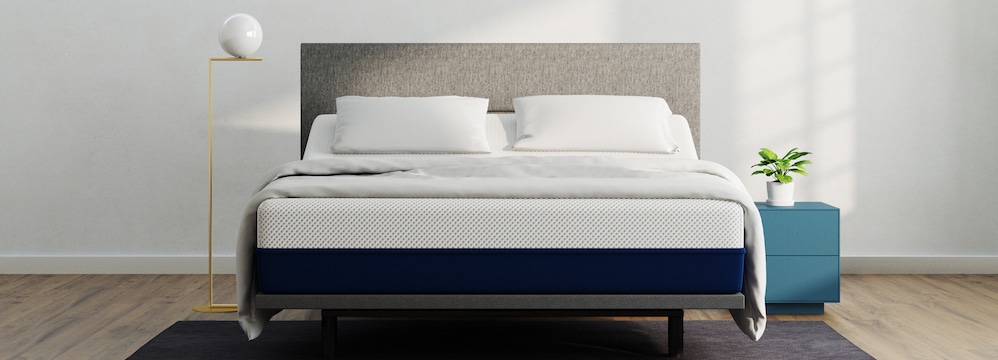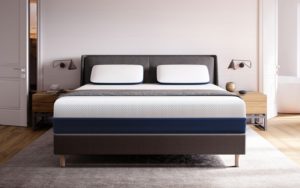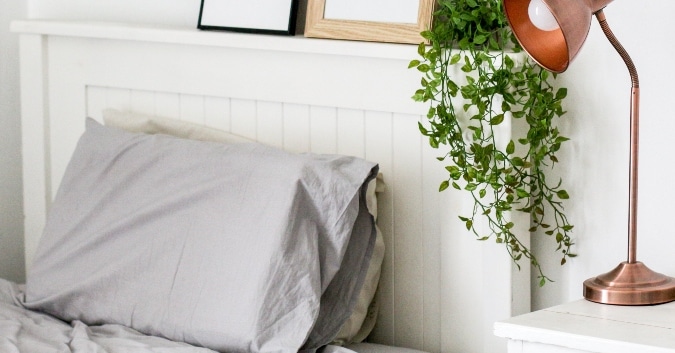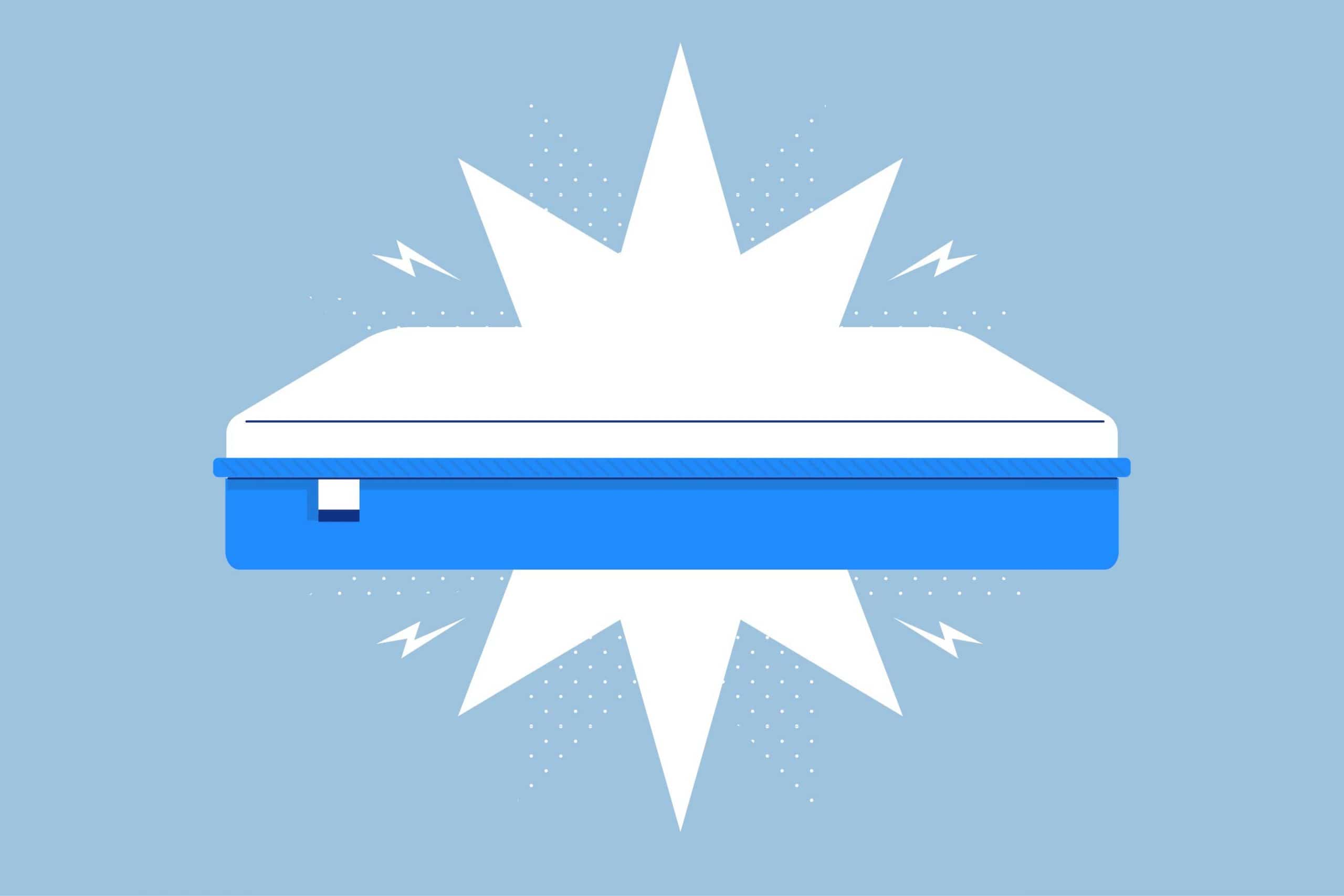Our favorite sleep position and mattress are directly tied to how well we sleep each night. The average adult needs 7 to 9 hours of sleep, but this can be hindered if we’re sleeping on the wrong mattress.
For combinations sleepers, the best mattress must provide consistent comfort and support, no matter the sleep position. Combinations sleepers switch between 2 to 3 different positions a night— the best mattress keeps the spine in alignment for better, healthier sleep.
Consider the Amerisleep AS3
As one of our most popular models, the Amerisleep AS3 mattress is an excellent choice for combination sleepers— the medium feel bed is designed for combination sleepers, providing excellent support and comforting pressure relief.
The Amerisleep AS3 mattress is 12 inches thick and contains 3 inches of Bio-Pur®, 2 inches of Affinity with HIVE® technology, and 7 inches of Bio-Core®.
Bio-Pur® comfort layer: Our proprietary Bio-Pur® comfort layer conforms to the body’s natural curves for optimal pressure relief. Bio-Pur® is a plant-based memory foam where castor oil partially replaces some of the petroleum during the manufacturing process. As a result, Bio-Pur® is more breathable and more responsive than traditional memory foam. Because of its eco-friendly production, Bio-Pur® emits little to no VOCs (Volatile Organic Compounds).
Affinity with HIVE® technology transition layer: Affinity is a foam transitional layer that uses HIVE® technology to form an ergonomic support system. Hundreds of hexagonal-shaped segments form 5 zones— softer support provides deeper compression to heavier sections of the body, like the shoulders and hips, with firmer support for the head, back, and legs. This layer also serves to keep the spine in neutral alignment.
Bio-Core® support layer: Bio-Core® is a low-density foam made through eco-friendly methods, resulting in little to no VOCs. Bio-Core® provides durability to the mattress and reinforces the top layers without the risk of sagging.
Sleep trial and warranty: We offer our customers a 100-night sleep trial and a 20-year warranty with every bed. During the first 10 years of the warranty, we will replace the mattress at no extra charge. During the last 10 years, we will either repair or replace the bed at a prorated charge.
What is a Combination Sleeper?
Unlike other types of sleepers, a combination sleeper switches between two to three sleep positions in one night. Combination sleepers are also known as “restless sleepers” because of their near-constant tossing and turning at night. Combination sleeping may improve blood circulation and reduce the risk of numb limbs because sleepers move around a lot during the night.
There are pros and cons to combination sleeping. These include:
- Pros:
- Better oxygen intake
- Improved blood circulation
- Healthy spinal alignment
- Reduced risk of snoring
- Less risk of numb limbs
- Cons:
- Neck strain
- Snoring potential
- Back pain
Other Sleeping Positions
Other sleeping positions include side sleeping, back sleeping, and stomach sleeping. Many mattress companies offer mattresses based on singular sleep positions, rather than the diverse combo sleeping position.
Side Sleeping
As one of the most popular and healthiest sleep positions, side sleeping allows for better breathing. Other benefits include reducing acid reflux, low snoring potential, and less pressure on vital organs, like the liver and heart. If you’re searching for the best mattress for side sleeping, look for a bed that offers cushioning under the shoulders and hips and is soft to medium in firmness.
Back Sleeping
Back sleeping is also rather healthy, though not as common as side sleeping. Back sleepers naturally keep their spines aligned because of their back’s direct contact with the sleep surface.
Back sleeping also allows for better breathing, but it comes with a higher risk of snoring and developing sleep apnea— gravity causes the soft tissue to collapse at the back of the throat, blocking airways. The best mattresses for back sleepers are typically medium to firm, as firmer mattresses evenly support the back for better spinal alignment.
Stomach Sleeping
Stomach sleeping is the least common and unhealthiest sleep position. Stomach sleepers have a higher risk of neck strain from twisting and holding the head at an unnatural angle to breathe. They also have a higher risk of lower back pain from gravity pulling the midsection down, forcing the natural curve of the spine to straighten.
We strongly encourage stomach sleepers to switch to the side sleeping position, but if you want to stick to stomach sleeping, then a medium-firm to firm mattress would be the best option. This firmness keeps the body on top of the sleep surface while allowing for a slight sinking of the body to relieve pressure points. Stomach sleepers can also add a thin pillow under the hips to keep the spine in alignment.
What You Need to Consider as a Combination Sleeper
Combination sleepers have more diverse needs than the other sleeping styles due to tossing and turning at night. No matter the sleep position, combination sleepers need a mattress to encourage consistent spinal alignment— misalignment causes more pressure points and an increase in pain. Features to consider include body weight, firmness and support, durability, mattress type, cooling properties, and price.
Firmness and Body Weight
Firmness is the feel of the mattress, measured on a scale between 1 (softest) and 10 (firmest). The firmness of a mattress depends on a person’s body weight— the more weight applied, the firmer the mattress needs to be to provide adequate support. The best type of firmness for a combination sleeper is medium to medium-firm.
A sleeper’s current body weight can affect how a mattress feels and the level of support you need. Bodyweight is divided into three categories: light, average, and heavy— each group needs a mattress with a specific firmness to align the spine and cushion the body.
- Lightweight Sleeper: weighs less than 130 pounds
Lightweight sleepers need a soft to medium-soft mattress since the softer surface allows their weight to slightly sink.
- Average Weight Sleeper: weighs between 130 pounds to 230 pounds
Average weight sleepers need a medium-soft to medium-firm mattress to conform and align the spine without deep sinkage.
- Heavyweight Sleeper: weighs over 230 pounds
Heavyweight sleepers need a medium-firm to firm mattress to support and conform to the body without sagging.
Support
The support of a mattress refers to the sleep surface’s ability to remain even when weight is applied, promoting healthy spinal alignment. A too soft or too firm mattress can lead to uneven surfaces and spinal misalignment.
Durability
Combination sleepers need a more durable mattress because regular movement increases wear and tear. A quality mattress lasts between 7 to 10 years, though the lifespan depends on how often the bed is used and the material quality.
Mattress Type
Benefits and drawbacks come with each type of mattress. Ultimately, the type of mattress you choose should be based on your sleep needs and personal preferences, especially since some mattress brands offer different firmness options.
Memory Foam
Memory foam is one of the most popular types of mattresses on the market today, and they’re the most common bed in a box mattress because they’re so easy to compress. A memory foam mattress contains a comfort layer of memory foam and a support layer of high-density foam. A quality memory foam mattress can last between 6-7 years.
Memory foam is an excellent choice for combination sleepers because it offers excellent pressure point relief by contouring to the body’s natural curves. Memory foam also has good motion isolation and is quiet both great qualities for combination sleepers and couples.
Because of its hug-like feel, memory foam runs the risk of retaining heat; however, manufacturers solve this problem through gel memory foam and copper-infused foam. Memory foam may also have higher off-gassing odor potential when first unboxed, but the scent fades after a few days.
When choosing a high-quality memory foam mattress, look at a foam’s density and ILD rating.
Density refers to how the mattress supports the body and is measured by the weight of one cubic square foot.
- Low density: 2.5 to 3.9 PCF
- Medium density: 4.0 to 5.4 PCF
- High density: 5.5 PCF and higher
ILD stands for “Impression Load Deflection,” and measures the amount of pressure it takes to make a 4-inch indentation in the sleep surface of the mattress. The lower the ILD rating, the softer the foam, and the higher the ILD rating, the firmer the foam. ILD ratings range between 8 as the softest, to 20 as the firmest.
- Extremely soft: 8 to 10
- Very soft: 11 to 15
- Soft: 16 to 21
Innerspring
Chances are you grew up sleeping on an innerspring mattress. An innerspring mattress, otherwise known as the traditional bed, contains a thin comfort layer made of foam or fiberfill (usually a pillow top) and a support layer of coils. Generally, an innerspring mattress lasts between 4 to 6 years.
Innerspring mattresses sleep cooler thanks to the open structure of their coil support layer. They also offer excellent edge support and a responsive bounce due to the steel coils. Innerspring mattresses are one of the most affordable options.
An innerspring mattress is not the best choice for combination sleepers, because while it provides ample support, it lacks contouring abilities found in memory foam and latex mattresses. It also has more noise potential, which could cause sleep disruptions.
To determine a quality innerspring mattress, check out the coil gauge and coil count. Coil gauge refers to the thickness of the coil, measured in millimeters. Low measurements mean a thicker coil and firmer support, while high measurements result in a thinner coil and softer support.
- Thickest: 12mm
- Thinnest: 18mm
Coil count refers to the number of coils found in a single layer inside a mattress. A quality mattress contains 500 to 1,000 steel coils— any mattress with less than 300 should be avoided since the mattress will break down sooner and won’t be able to offer adequate support. In the same sense, if a mattress has a high number of coils, look at the coil gauge. If the coil gauge is high, there’s an increased risk of sagging.
Latex
Latex foam is created one of two ways— through synthetic means involving a chemical process or naturally, by extracting sap from rubber trees. There are two forms of natural latex: Dunlop and Talalay. Dunlop latex is denser and more durable, while Talalay latex is softer with strategically-placed holes in the material, increasing airflow and support.
A typical latex mattress contains a comfort layer of latex and a support layer of either high-density foam or latex foam. Latex mattresses last between 7 to 8 years. Like memory foam, take a look at the density and ILD rating of latex to determine a quality latex mattress.
A latex mattress is a great choice for combination sleepers because they are naturally cool and offer excellent pressure relief. Latex mattresses provide good motion isolation and produce no noise, plus they offer a responsive bounce, making movement easier.
One drawback of latex mattresses is their high price tag— potential shoppers can expect to pay more for natural materials. Off-gassing odor potential is another drawback, though it won’t be as strong as memory foam and fades after a few days.
Hybrid
A hybrid mattress is the perfect combination of memory foam and innersprings. This type of mattress was created to offer customers the best of both worlds— conforming pressure relief and responsive, coiled support. A hybrid mattress contains a comfort layer of memory foam and a support layer of pocketed coils. A true hybrid must contain a comfort layer at least 2 inches thick and a coiled support system.
Hybrid mattresses last 6 to 7 years. To find a quality hybrid mattress, take a look at the foam’s density and ILD rating, and coil gauge and coil count.
A hybrid mattress is a good option for combination sleepers— this type of mattress offers conforming pressure relief through the comfort layer and good edge support and cooling through the support layer.
While a hybrid mattress offers sleepers the benefits of both memory foam and innersprings, they also provide the drawbacks of both. Hybrid mattresses offer less pressure relief than memory foam or latex mattresses and may risk overheating. Due to the steel coils, there is less motion isolation transfer with the potential for noise. Plus, because hybrids contain lots of materials, they’re both heavy and expensive.
Cooling Properties
Cooling properties are always worth looking into when searching for a high-quality mattress— they prevent overheating at night and can also improve sleep quality and recovery; sleeping cool means fewer disruptions and longer time spent in the REM cycle. Cooling properties are found in both foam and innersprings.
Foam
- Plant-Based
Partially replacing petroleum oil with plant oil in the production of memory foam creates a more porous and breathable foam that has little to no VOCs.
- Infusions
Infusing foam with gel, copper, or graphite pulls heat away from the body and evenly disperses it. Some infusions, like copper, can also improve blood circulation and muscle recovery.
Innersprings
Innerspring coils offer cooling through their open structure— coils allow more air to flow freely within the mattress.
Price
Before you begin your search for the best mattress for combination sleepers, make sure to set a budget based on the type of mattress you want. Prices range between $500 to over $2000— on average, potential shoppers can purchase a good quality mattress for $1500.
Since memory foam and latex mattresses are the best options for combination sleepers, we recommend checking out bed-in-a-box brands. By cutting out the middleman, these online mattress companies can use high-quality materials at a lower cost. Plus, purchases include extended sleep trials, giving customers plenty of time to try out a new mattress within the comfort of their own home.
Other Features
Other features combination sleepers should consider include responsiveness and motion isolation— these features can provide better sleep through ease of movement and isolating motion.
Responsiveness
The responsive bounce to a mattress prevents sleepers from feeling stuck inside the bed and allows for easier movement, a key feature for combination sleepers. Easier movement also means less chance of pulled muscles.
Motion Isolation
Another great feature for combination sleepers is motion isolation. Because of their regular movement, combination sleepers may wake or wake their sleep partner up several times during the night. Motion isolation found in memory foam and latex mattresses prevent motion from spreading, ensuring better sleep for you and your sleep partner.
Sleep Trials, Warranties, and Return Policies
Sleep trials, warranties, and return policies act as assurances of a sound purchase to the customer. Always read the fine print, and be wary of a mattress that doesn’t offer a sleep trial, warranty, or return policy— it could be a sign of a poor quality bed.
Sleep Trial
Sleep trials allow customers to try out a mattress without pressure to buy. These trial periods last between 90 to 120 nights, depending on the brand. Should the customer not like the mattress, they can return or donate the mattress for a full refund.
Warranty
A warranty protects the mattress against flaws, defects, and sagging greater than 1 inch (sagging measurement varies depending on the brand). Most mattresses come with a standard 10-year warranty. Customers should always read the fine print before committing to a purchase to know what to expect of the manufacturer and what the manufacturer expects of the customer.
Return Policy
If a sleep trial isn’t available, look at the return policy. A return policy lasts 30 days— the same amount of time it takes the body to adjust to a new mattress. If the customer isn’t satisfied with the bed, they can return it for a full refund.
Finding the Right Mattress
Because of their constant movement, combination sleepers need a mattress that will automatically adjust to each sleep position for consistent comfort and support. The best option is the Amerisleep AS3. The AS3 is made of eco-friendly foam layers, designed to contour to the body for excellent pressure relief without restricting movement.
About the author
McKenzie Hyde is a Certified Sleep Science Coach and a full-time writer focused on sleep health and the mattress industry. She currently writes articles on a variety of topics, ranging from sleep hygiene to the newest trends in the mattress and bedding industry. Just some of the topics she has covered include best sleep practices for students, the consequences of going without sleep, and choosing the right bed if you suffer from back pain. McKenzie Hyde holds a Master of Arts degree from Utah State University where she studied literature and writing. While there, she taught argumentative writing and wrote a variety of articles and analyses for literary and academic journals.
View all posts






